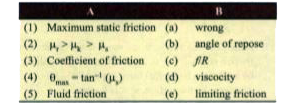If a constant retarding force is applied on an object moving backwards, i.e., ν=u−at becomes negative after (at>u) .But, even if you hold the brake lever pressed in your bicycle, it does not go backwards after coming to rest. Comment.
Friction force is a self-adjusting force
ν=u−at become negative only if .a. and .f. are constants.
Topper's Solved these Questions
- FRICTIONBOOK - CENGAGE PHYSICSCHAPTER - FRICTIONEXERCISE - CONSOLIDATED EXERCISE.
1 Video
- FRICTIONBOOK - CENGAGE PHYSICSCHAPTER - FRICTIONEXERCISE - CONSOLIDATED EXERCISE. (MULTIPAL-CHOICE QUESTION WITH ONE OR MORE THAN ONE CORRECT ANSWER)
3 Videos
- FRICTIONBOOK - CENGAGE PHYSICSCHAPTER - FRICTIONEXERCISE - OLYMPIAD AND NTSE LEVEL EXERCISES (Read the given statements and select the correct option.)
1 Video
- ELASTICITYBOOK - CENGAGE PHYSICSCHAPTER - ELASTICITYEXERCISE - OLYMPIAD AND NTSE LEVEL EXERCISES
7 Videos
- SOUNDBOOK - CENGAGE PHYSICSCHAPTER - SOUNDEXERCISE - OLYMPIAD AND NTSE LEVEL EXERCISE
10 Videos
Similar Questions
Match the following :

View SolutionMark the correct statements about the friction between two bodies
View SolutionAssertion: Friction is a self-adjusting force.
Reason: Friction does not depend upon mass of the body.
View SolutionA steel rod of length 1m and radius 10 mm is stretched by a force 100 KN along its length. The stress produced in the rod YSteel=2×1011 N m−2
View SolutionWhich of the following is correct about Doppler effect?
View SolutionA constant retarding force of 50N is allied to a body of mass 10kg moving initially with a speed of 10ms−1 . The body comes to rest after
View SolutionA car is moving with speed u. Driver of the car sees red traffic light. His reaction time is t, then find out the distance travelled by the car after the instant when the driver decided to apply brakes. Assume uniform retardation 'a' after applying brakes.
View SolutionA body of mass 'm' is travelling with a velocity 'u' . When a constant retarding force 'F' is applied , it comes to rest after travelling a distance s1 . If the initial velocity is 2u , with the same force F , the distance travelled before it comes to rest is s2 . then
View SolutionA car of mass 1000 kg is moving at a speed pf 30 m/s. Brakes are applied to bring the car to rest. If the net retardation force is 5000 N, the car comes to stop after travelling d m in ts. Then
View Solutionएक कार u वेग से गतिमान है। चालक ट्रेफिक सिग्नल को देखकर ब्रेक लगाकर a मंदन आरोपित करता है तो वीरामवस्था में आने से पूर्व कार द्वारा तय की गई दूरी ज्ञात कीजिए। (ड़्राइवर का प्रतिक्रिया समय है)
View SolutionA car of mass 1000 kg is moving at a speed 30 m/s. Brakes are applied to bring the car to rest. If the net retardation force is 5000 N, the car comes to stop after travelling d m in t s. Then
View SolutionA car of mass 1000 kg is moving at a speed 30 m/s. Brakes are applied to bring the car to rest. If the net retardation force is 5000 N, the car comes to stop after travelling d m in t s. Then
View SolutionA constant retarding force of 50N is apllied to a body of mass 10kg moving initially with a speed of 10ms^(-1) . The body comes to rest after
View SolutionA motor car weighing 500 kg is moving with a speed of 15 m/s and the speed reduces to 5 m/s after brakes are applied. Calculate the value of retarding force after brake is applied ?
View SolutionA car come to rest when brake was applied for 4s to get a retardation of 3m / s^2 .Calculate how far the car would have travelled after applying the brake.
View SolutionA car moving with a speed of 108km/h comes to rest after 4s on applying brake. If the mass of the car including the passengers is 1000kg, what will be the force apllied when brake is applied ?
View Solution

